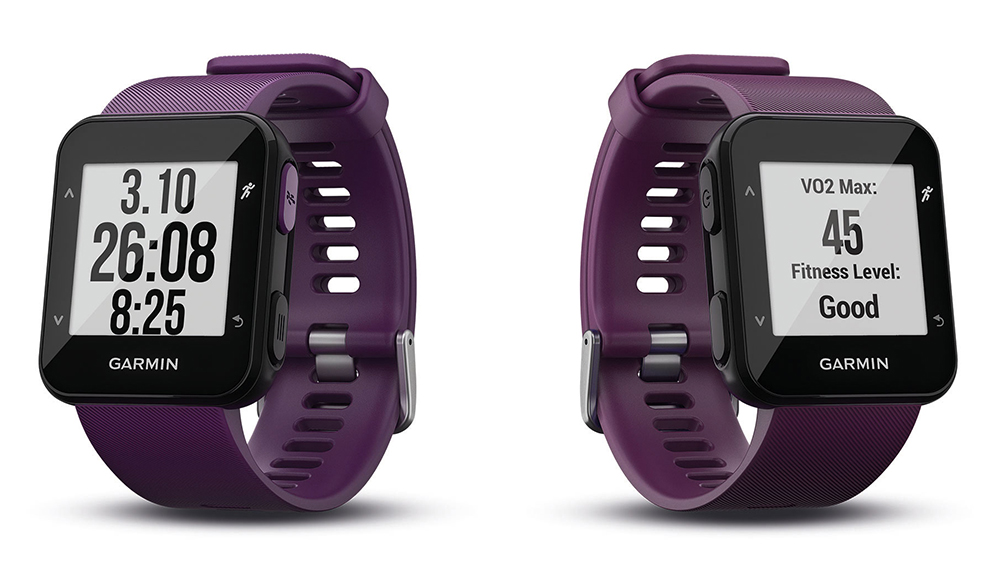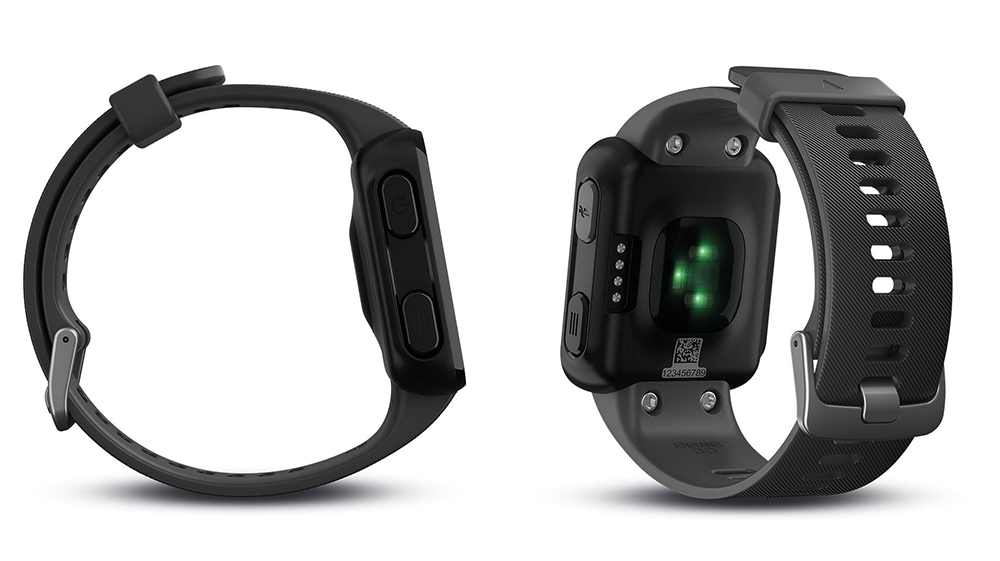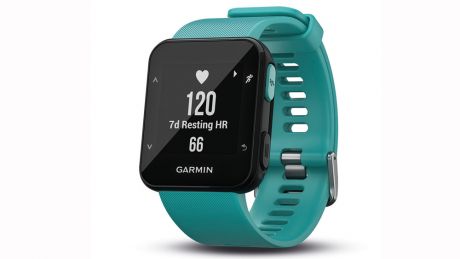For
- One advantage of having few features is that the Forerunner 30 is incredibly simple to use. Click one button, wait for the GPS to lock on and off you go.
- The Forerunner 30 tracks GPS accurately and finds a signal quickly. It also syncs activities to your smartphone incredibly promptly – I was genuinely incredulous the first time I synced a run, to the point where I checked it wasn’t a past activity.
- All-day tracking includes continuous heart rate monitoring, move alerts, steps and calories burned, and the Forerunner 30 estimates both your resting heart rate and your VO2 max, both useful measures of your general fitness.
- The heart rate monitoring is, broadly speaking, accurate. There were a few ups and downs during runs but it is reliable enough to be useful.
- Move IQ recognises when you’re doing an activity that isn’t running and tags it correctly in the app…
Against
- …although the lack of a multi-sport mode on the watch means that only runners get relevant stats during their training.
- There is no workout or even basic intervals mode, which would be very useful for lots of runners.
- The everyday tracking stats are good, but the Forerunner 30 is a bit blocky compared to the more stylish fitness trackers like the Fitbit Alta HR or Misfit Ray, and you might not fancy wearing it when not running.
You can trust Coach
- NEWS FLASH: New Garmin Forerunner watches improve GPS accuracy, here’s what else is new on the 255 and 955
- First-look Garmin Forerunner 255 review
- First-look Garmin Forerunner 955 review
Garmin Forerunner 30 In-Depth
Using The Garmin Forerunner 30 For Running

The Forerunner 30’s raison d’etre is to be a back-to-basics run tracker and it does this very well.
To operate it you simply click the top-right button to get the Forerunner 30 to start hunting for GPS satellites, which it always located within 30 seconds in my experience, then click it again to start running. The GPS is accurate, which means you can use the Forerunner 30 to pace your runs reliably.
You can customise the three data screens through the Garmin app, as well as adding a fourth which shows the time and date. You don't get as many options as on more advanced trackers, but everything you really need is there – duration, distance, pace, heart rate and the like, and there’s also cadence if you’re keen to keep tabs on your stride rate.
You can set the Forerunner 30 to send updates on your run every mile or kilometre, depending on your preferred metric, and there’s an auto-pause feature you can turn on for those stop-start runs in the city.
For the most part, the heart rate tracking is accurate too. I had a couple of runs where it ran very high, but on the vast majority of outings it was within 5bpm of a chest tracker, and didn’t lag too much when I ran up a hill or increased my pace suddenly.
Now on to what you can’t do, which is set up and follow workouts or even basic interval sessions. It might seem churlish to pick on a budget tracker for this, but the basic TomTom Spark is in the same price bracket and does offer customisable workouts (if not heart rate tracking), as does the Forerunner 35. Although the Forerunner 30 is £30 cheaper than the 35 and £40 cheaper than the Spark 3 version with heart rate tracking if you go by RRP, shop around – not much, you’ll probably have to just check Amazon – and you’ll find both for a similar price as the 30. Still, the 30 will probably drop in price in a similar fashion after a while, and if it ends up around £100 then it’ll be a five-star option for bargain-hunting runners.
Using The Garmin Forerunner 30 As An Activity Tracker
You can’t select any sports other than running on the watch itself, but if you use it to record walks or bike rides, they’ll be tagged as such automatically in the app (any other activities will be labelled as “other”). With walks and cycles you’ll get a map of your activity in the app, along with other key stats like calories, average speed, heart rate and elevation gain, but during the activity itself only a few of the stats on screen will be relevant because they are tailored to running.
Sign up for workout ideas, training advice, reviews of the latest gear and more.
The Forerunner 30 does a little better when it comes to all-day tracking, with continuous heart rate monitoring, steps, calories (active and overall) and intensity minutes all tracked and your progress easily viewed on the watch itself. The device will also buzz at you if you remain still for too long and remind you to fill up the “Move Bar” – a line on the bottom of the home screen that’s cleared with any movement (get up, walk about for a few minutes and it’s cleared). You can adjust the step and weekly intensity minute targets easily in the app, and turn off the move notifications if they get too annoying – and they are annoying, which I guess is the point.
All this info is synced with the Garmin Connect app, which has benefitted from an impressive redesign of late (more on which later), especially with regards to the My Day stats, which sum up your various activities well.
Using The Garmin Forerunner 30 As A Heart Rate Monitor

The Forerunner 30 is packing Garmin’s Elevate wrist heart rate monitoring tech, which I’ve generally found to be pretty reliable, certainly for all-day tracking and steady exercise. On a few runs I found it overestimated my heart rate quite drastically in the first mile or so – perhaps because it locked on to my cadence rather than heart rate – but would usually settle down and track correctly thereafter.
Continuous heart rate monitoring allows the Forerunner 30 to provide a resting heart rate measurement, which, along with the VO2 max measurement it estimates (which is based on heart rate during exercise), gives a solid indication of your general fitness. If you track your resting heart rate and VO2 max over time with the Forerunner 30, and they go down and up respectively, you can be reliably sure you’re getting fitter.
RECOMMENDED: The Best Heart Rate Monitors
Using The Garmin Forerunner 30 For Calorie Counting
The Forerunner 30 logs your active and resting calories burned, as well as giving an overall total. The latter is useful because it gives a handy overall guide as to how much you should be eating each day if, say, you’re trying to create a calorie deficit or maintain weight.
Each exercise you track will have a specific calories burned tally, and you can set calories to be one of the stats shown on-screen during exercise, if you’re looking to hit a certain target with your workout.
Using The Garmin Forerunner 30 As A Sleep Tracker
The Forerunner 30 does track your sleep, giving details on total time asleep, broken down by deep and light sleep. It also shows how much you moved during the night. In my experience, the Forerunner 30 had a tendency to assume I was asleep during the hours I set up as my normal bed and wake times, resulting in inaccurate sleep times.
On the plus side the movement tracking is quite interesting (if you only look at the periods when you know you were actually asleep) and I found I moved a fair bit more at night after a boozy evening. The Forerunner 30 is also slight and comfortable enough that it doesn't annoy when worn during the night, which is always the first key test of any sleep tracker.
RECOMMENDED: The Best Sleep Trackers
Using The Garmin Forerunner 30 As A Smartwatch
As you’d expect, the Forerunner 30 doesn’t offer any fancy smartwatch features like space for music or Garmin Pay, but it will show basic notifications like calls and texts. Then you can get your phone out and respond to them.
The Garmin Connect App
Garmin has recently updated the Connect app and the home screen is now much improved. A series of cards shows all the details on your day, including heart rate (resting and high), any activities you’ve undertaken, steps, intensity minutes (broken down by moderate and vigorous, the latter counts double), calories and sleep. There are also cards for yesterday and the past seven days.
It’s all useful information and intuitively presented, especially compared with the old app. You can click through for more details on any of the cards, including charts of the previous 24 hours, seven days, four weeks and 12 months for all the stats shown, and more detail on individual activities, including the GPS map.
RECOMMENDED: The Best Health And Fitness Apps
How Often Am I Going To Have To Charge It?
The Forerunner 30 offers eight hours of GPS and five days in watch mode. If you wear it all the time and use it for several runs and cycles a week it will need one, maybe two charges to see out seven days, but I found that it was impressive in minimising battery usage when I wasn’t wearing it. If I left it in a drawer for a few days I could come back and it would still have a good chunk of battery life left, meaning if you just use it for running you might squeak through a week without charging it.
Where Can I Wear It Without People Laughing At Me?
With the black strap the Forerunner 30 is a fairly subtle affair, but the boxy design and plastic casing makes it something I suspect most people will only want to wear when actually exercising. It’s not a horrible watch to look at by any means, but it’s also not smart enough for the office or nights out, which of course does make the everyday tracking less useful.
Should I Consider Buying Something Else?
If it was £100 – and it might end up dropping to that price in time – the Forerunner 30 would be the obvious choice for a bargain running watch, but at £130 there are other, slightly more advanced options available, including Garmin’s own Forerunner 35 and the TomTom Spark, which both have multi-sport modes and the ability to follow structured workouts on the fly. Despite the Forerunner 30’s impressive capabilities, I’d lean towards one of those two for the extra features on offer.
If you’re just looking for an everyday tracker, I’d also say that Fitbit has two options to consider at a similar price – the Charge 2 and Alta HR. Neither has built-in GPS, but they are better everyday trackers and more stylish. And if you’re on the hunt for the cheapest GPS tracker available, the £79.99 Huawei Band 2 Pro is definitely worth considering.

Nick Harris-Fry is a journalist who has been covering health and fitness since 2015. Nick is an avid runner, covering 70-110km a week, which gives him ample opportunity to test a wide range of running shoes and running gear. He is also the chief tester for fitness trackers and running watches, treadmills and exercise bikes, and workout headphones.

